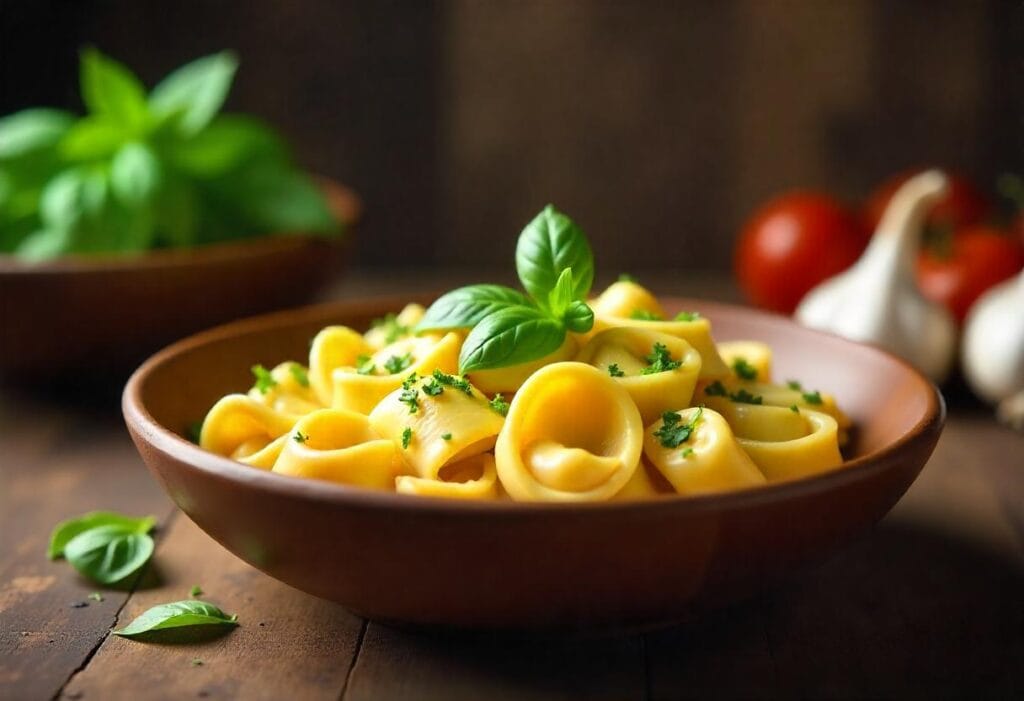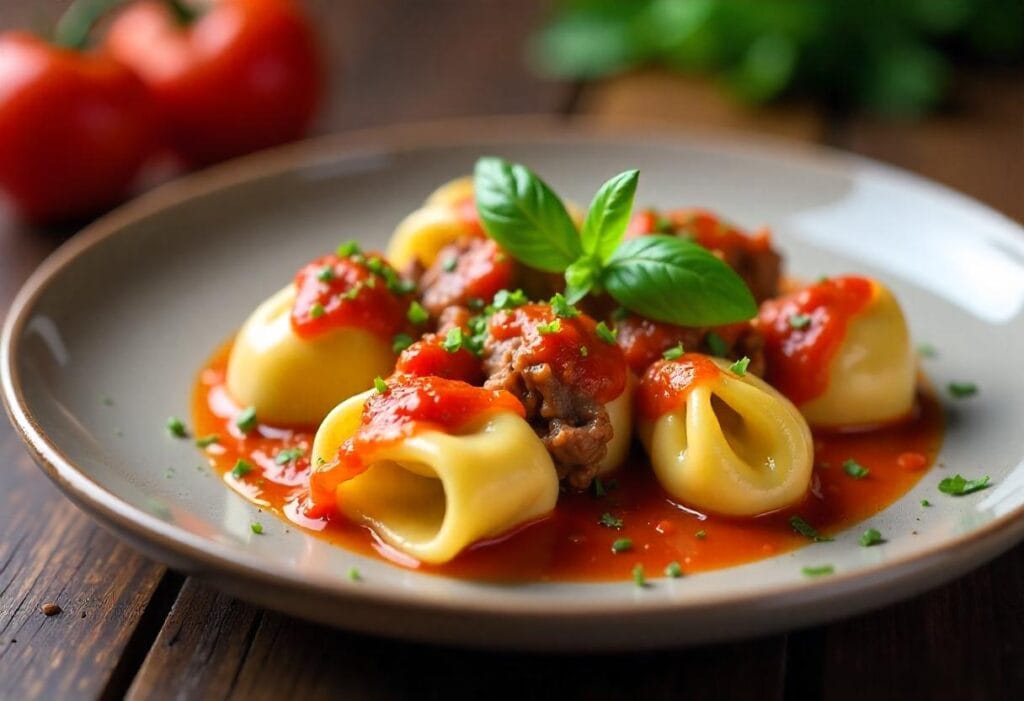Table of Contents
Italian pasta, a delight for food lovers around the world, has a rich diversity of shapes, fillings, and preparation methods. Among these, tortellini and cappelletti stand out as two beloved varieties that often spark debates about their similarities and differences. Whether you’re a pasta aficionado or someone simply eager to learn about Italian cuisine, you may wonder: What is the difference between tortellini and cappelletti? Let’s break it down!
What is Tortellini?
Tortellini is a small, ring-shaped stuffed pasta that has become a hallmark of Italian cuisine, particularly in the Emilia-Romagna and Tuscany regions. Its name is believed to derive from the Latin word “torere,” which means “to twist,” referring to the way the pasta is folded. Typically, tortellini is filled with a rich mixture of meat, cheese, or a combination of the two.
Tortellini: Origins and Tradition
The exact origins of tortellini are widely debated, but it is generally accepted that the pasta originated in Bologna or Modena, cities in Emilia-Romagna. Tortellini has historically been served in broth (brodo), but it’s also enjoyed with rich, cream-based sauces or tomato sauces.
« The beauty of tortellini lies in its size and shape – a tiny pasta that carries a big flavor. » 🍝

Classic Tortellini Filling
Traditionally, tortellini is filled with prosciutto, pork, or beef, sometimes mixed with Parmesan or other cheeses, making for a deliciously savory bite. The fillings are finely minced, ensuring a smooth, melt-in-your-mouth experience when cooked.
What is Cappelletti?
While tortellini is more widely recognized, cappelletti is another classic stuffed pasta that hails from Emilia-Romagna and the Marche region. Cappelletti, which means « little hats » in Italian, gets its name from the way the pasta is shaped, resembling small hats. This pasta, similar to tortellini, is also stuffed, but its size is slightly larger and its shape is often more open.
Cappelletti: Origins and Tradition
Like tortellini, cappelletti is steeped in Italian tradition, but it’s generally found more often in Marche, where it’s traditionally served in a flavorful broth. Cappelletti also has a reputation for being more rustic than tortellini, with its fillings and dough often showcasing regional differences and the influence of local ingredients.
For a deeper dive into the history and meaning behind this iconic pasta, check out What is the Meaning of Cappelletti Pasta?.
« Cappelletti may be a little larger and open than tortellini, but it’s no less delicious! » 🍲

Classic Cappelletti Filling
Cappelletti fillings are typically cheese-based (like ricotta) or meat-based, but the choices can vary. In some cases, cappelletti may include vegetables like spinach or herbs to complement the filling.

What is the Difference Between Tortellini and Cappelletti? Key Distinctions
Now that we’ve defined both tortellini and cappelletti, let’s take a deeper dive into their most noticeable differences. From their shape and size to their origins and fillings, understanding these distinctions will give you a better appreciation of these two unique pasta types.
Shape and Size
One of the most noticeable differences between tortellini and cappelletti is the size and shape. Tortellini are smaller and tend to have a tight ring shape, while cappelletti are slightly larger and more open. The overall shape of tortellini resembles a small ring, often folded over, and tightly sealed.
Cappelletti, on the other hand, resembles a miniature hat or pouch that’s loosely folded at the top. This more open form allows the filling to be seen more easily than with tortellini.
Regional Origins and Variations
Both tortellini and cappelletti hail from northern Italy, but they are strongly associated with different regions. Tortellini is most closely linked with Emilia-Romagna, especially Bologna and Modena, while cappelletti is more commonly found in Marche and parts of Emilia-Romagna. The difference in regional association leads to subtle variations in their fillings, serving methods, and traditions.
« The beauty of Italian pasta lies in its regional diversity – each type has its unique story and origin. » 🇮🇹
Fillings: Meat vs. Cheese
Another important distinction between tortellini and cappelletti lies in their fillings. While both can be stuffed with a combination of meat and cheese, tortellini fillings tend to have more meat such as pork, beef, or prosciutto, combined with a small amount of cheese.
On the other hand, cappelletti is more likely to be filled with cheese (such as ricotta), making it lighter in flavor. Cappelletti is also more likely to feature vegetarian options, making it a versatile choice for different dietary preferences.
What is the Difference Between Tortellini and Cappelletti Preparation Methods?
Both tortellini and cappelletti are made in similar ways, but their sizes and folding techniques set them apart. Let’s take a closer look at the step-by-step process of making each pasta type.
Making Tortellini: Step-by-Step
- Prepare the Dough: Start with a simple dough of flour and eggs. Knead the dough until it’s smooth and elastic, then allow it to rest.
- Roll Out the Dough: Roll the dough into thin sheets, either by hand or with a pasta machine.
- Cut into Squares: Once the dough is rolled out, cut it into small squares, typically about 2 inches on each side.
- Add the Filling: Place a small amount of the prepared filling (usually meat and cheese) in the center of each square.
- Fold and Seal: Fold the dough into a triangle, then bring the edges together to form a small ring. Press the edges tightly to seal the filling inside.
- Cook: Boil the tortellini in salted water until it floats, indicating it’s done.
Making Cappelletti: Step-by-Step
- Prepare the Dough: Like tortellini, cappelletti begins with a dough made of flour and eggs.
- Roll and Cut: Roll the dough thin, then cut it into larger squares than tortellini.
- Add the Filling: Spoon the filling (often a combination of cheese or meat) onto each square.
- Fold and Shape: Fold the dough into a smaller triangle, but leave the top of the triangle open to form a hat-like shape.
- Cook: Boil the cappelletti in broth or water until they float.
Common Problems When Making Tortellini and Cappelletti
Even the most experienced cooks can run into problems while making tortellini or cappelletti. Here are some common mistakes and how to solve them:
Problem 1: Dough Is Too Tough
If the dough feels hard and difficult to work with, it’s likely overworked or doesn’t have enough moisture.
Solution: Add a small amount of water or olive oil and knead the dough until it becomes soft and elastic.
Problem 2: Filling Leaks Out
A common issue when making stuffed pasta is having the filling leak out during cooking.
Solution: Ensure the edges are sealed tightly when folding and pinching the pasta. A little bit of egg wash around the edges can also help with sealing.
Common Uses and Serving Methods for Tortellini and Cappelletti
Now that we’ve covered the differences in their shapes, fillings, and origins, let’s dive into how tortellini and cappelletti are typically served. These two pastas are known for their versatility in the kitchen, each bringing unique flavors and textures to the table.
Want to discover more creative ways to serve cappelletti? Explore What is Cappelletti Used For? for inspiration.
Tortellini in Broth and Sauces
The most traditional way to serve tortellini is in a broth. This method is particularly popular in Emilia-Romagna, where the tiny pasta is cooked in a rich meat broth. The broth brings out the flavors of the meat-filled tortellini, allowing the pasta to absorb the savory flavors while keeping the dish light.
Tortellini can also be served in a variety of sauces:
- Tomato-based sauces: A classic marinara or pomodoro sauce pairs wonderfully with cheese-filled tortellini, balancing the richness of the cheese with the acidity of the tomatoes.
- Creamy sauces: A cream-based sauce (think Alfredo or mushroom cream sauce) complements the meat-filled tortellini, providing a rich and indulgent dish.
- Pesto: Fresh basil pesto works beautifully with cheese tortellini, creating a fresh and aromatic dish.
Cappelletti in Broth and Sauces
Like tortellini, cappelletti is often served in broth. This method is especially traditional in Marche and Emilia-Romagna. The cappelletti floats in a delicious, clear broth (often made from chicken or beef), absorbing the flavors of the broth. The delicate pasta is the star, with the simple broth providing the perfect backdrop.
In addition to broth, cappelletti can be served with:
- Butter and sage: A simple but effective sauce for cheese-filled cappelletti. Browned butter with crispy sage leaves gives the dish a fragrant finish.
- Tomato sauce: Like tortellini, cappelletti can also be paired with tomato-based sauces, particularly for a meat-filled cappelletti.
- Creamy sauces: For a richer dish, cappelletti can be served with cream sauces, such as bechamel or Alfredo.
Culinary Pairings and Sauces for Tortellini and Cappelletti
Tortellini and cappelletti are extremely versatile when it comes to sauces and pairings. Whether you prefer broth, sauces, or even pesto, these pasta types can handle almost any flavor profile you throw at them.
If you enjoy learning about unique pasta shapes, you might also like reading about Wagon Wheel Pasta: A Fun and Versatile Shape.
Classic Sauces for Tortellini
- Tomato Sauce: A classic pairing for cheese-filled tortellini, giving the pasta a fresh, slightly tangy finish.
- Pesto Sauce: Basil pesto provides a fresh, herby flavor that complements the richness of cheese-filled tortellini.
- Creamy Sauces: Mushroom cream sauce or a simple cream sauce provides richness that pairs wonderfully with meat-filled tortellini.
Classic Sauces for Cappelletti
- Butter and Sage: A butter and sage sauce is simple but allows the flavor of cheese-filled cappelletti to shine.
- Tomato Sauce: Meat-filled cappelletti works beautifully with tomato-based sauces, like marinara or pomodoro.
- Pesto: Similar to tortellini, cappelletti can be paired with a fresh basil pesto for a delightful burst of flavor.
« The versatility of both tortellini and cappelletti lies in how well they pair with various sauces, whether you enjoy the richness of cream or the freshness of tomato and basil. » 🍝
The Role of Tortellini and Cappelletti in Italian Cuisine
Tortellini and cappelletti are deeply ingrained in Italian culture. These small pastas, despite their differences, have become staples in Italian cuisine, loved for their flavor, versatility, and rich history.
Tortellini in Emilia-Romagna
In Emilia-Romagna, tortellini is more than just a dish—it’s part of the region’s heritage. Whether it’s served in a rich meat broth or paired with a decadent cream sauce, tortellini is a beloved tradition in homes and restaurants alike.
« In Emilia-Romagna, tortellini is a symbol of tradition, and it’s often served at special occasions and festivals. »
Cappelletti in Marche and Emilia-Romagna
Similarly, cappelletti has strong ties to Marche and parts of Emilia-Romagna, where it’s served in a variety of ways. Whether broth-based or paired with rich sauces, cappelletti carries the comforting essence of Italian home cooking.
« Cappelletti is often a dish that’s made for family gatherings and special occasions, capturing the essence of Italian hospitality. » 🇮🇹
Common Problems When Making Tortellini and Cappelletti
Making tortellini and cappelletti can be tricky, especially for beginners. Here are some common issues that people face, along with solutions to help you get the perfect pasta every time.
Problem 1: Dough Doesn’t Hold Shape
Sometimes the dough may not hold its shape, leading to gaps or tears when forming the pasta.
Solution: Make sure to knead the dough well and let it rest. If it’s too sticky, add a little more flour. Also, ensure that your filling isn’t too wet, as excess moisture can affect the dough’s ability to hold together.
Problem 2: Filling Spills Out During Cooking
If the filling spills out during cooking, you might end up with a mess in your pot.
Solution: Ensure the edges of the pasta are tightly sealed when forming tortellini or cappelletti. Egg wash around the edges can also help create a seal. Additionally, make sure the filling isn’t too liquid, as this can cause it to leak out.
Health Benefits and Nutritional Information
While both tortellini and cappelletti are indulgent, they offer several nutritional benefits, depending on the fillings used.
Tortellini’s Nutritional Value
Tortellini, especially meat-filled tortellini, can provide a good amount of protein. If served in broth, it can be a lighter option compared to pasta with a heavy sauce. However, if paired with cream-based sauces, it can become high in fat and calories.
Cappelletti’s Nutritional Value
Cappelletti made with cheese fillings (like ricotta) is a good source of calcium and protein. However, similar to tortellini, the sauces you choose to pair it with will influence the overall nutritional value.
Where to Buy Authentic Tortellini and Cappelletti
Finding authentic tortellini or cappelletti can be a treat! These pastas can often be found in Italian markets, gourmet stores, or even online. Be sure to check labels for authenticity and look for fresh pasta options that use traditional recipes for the best experience.
Frequently Asked Questions (FAQ)
1. Can Tortellini and Cappelletti Be Substituted for Each Other?
While tortellini and cappelletti are very similar, with both being small, stuffed pasta, they have distinct shapes and fillings. Tortellini is typically smaller, with a more tightly folded ring shape, while cappelletti tends to be slightly larger and more open, resembling a small hat.
If you find yourself in a pinch and can’t get one, you can substitute one for the other, but the overall texture and appearance may differ slightly. Cappelletti works better in soups and broths, while tortellini is more commonly served with a variety of sauces.
2. Are Tortellini and Cappelletti Always Served in Broth?
No, both tortellini and cappelletti can be served in various ways. While they are traditionally served in broth, these pastas are incredibly versatile. They can be paired with cream sauces, such as Alfredo or mushroom sauce, or even tossed in a tomato sauce for a hearty meal. The choice of sauce depends on your personal preference and the filling used in the pasta.
3. Can I Make Tortellini and Cappelletti Ahead of Time?
Absolutely! Both tortellini and cappelletti can be made ahead of time. After preparing the pasta, you can freeze it, making it easy to store and cook later. If you’re planning to serve it immediately, prepare the pasta a few hours ahead and refrigerate it. When you’re ready to cook, simply boil or cook the pasta in broth or sauce as usual.
« Making pasta ahead of time is a great way to save on preparation time while still enjoying delicious homemade flavors! » 🍝
4. How Can I Store Leftover Tortellini or Cappelletti?
If you have leftovers, store them in an airtight container in the refrigerator for up to 3 days. You can also freeze cooked tortellini or cappelletti for 1-2 months. To reheat, simply boil the pasta again in broth or water for a quick and easy meal.
5. Can I Use Store-Bought Tortellini and Cappelletti Instead of Homemade?
While homemade pasta offers a rich, authentic taste, store-bought versions of tortellini and cappelletti can be a good alternative for those short on time. Make sure to choose high-quality pasta from a reputable brand. These options are typically pre-cooked and filled with delicious ingredients, but they may not match the freshness and tenderness of homemade pasta.
Conclusion: Tortellini vs. Cappelletti – Which One Will You Choose?
Both tortellini and cappelletti are classic Italian pastas that showcase the richness of Italian cuisine. While they share many similarities, such as being stuffed pastas filled with savory meats or cheeses, they each have distinct characteristics that set them apart.
- Tortellini is more famous for its small, ring-like shape and is often served with broth or in rich cream sauces.
- Cappelletti, on the other hand, is slightly larger and open, with more flexibility in fillings and sauces.
Whether you’re enjoying tortellini in a broth or tossing cappelletti in butter and sage, both are delightful choices that will bring a taste of Italy to your table. The key takeaway is that both pasta types offer delicious flavors, so it’s up to you to decide which one suits your taste and your dish best!
« No matter your choice, both tortellini and cappelletti will bring a bit of Italian tradition to your kitchen! » 🇮🇹

